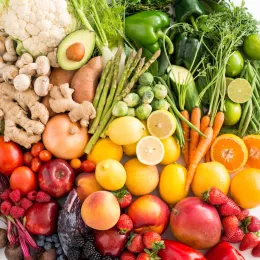The growing interest in the impact of food on disease and its role in the prevention or treatment of disease is being celebrated by the medical field and the culinary arts, and we as physicians are thrilled to be collaborating with a group of phenomenal chefs over the next couple of months to explore how the medical science of food, nutrition, and the art and science of cooking intersect.
Patients often ask us what they can eat and what to avoid. Is there bad food? The answer is yes, there certainly are bad foods: Think of certain berries or mushrooms containing toxins that are poisonous to humans or food that passed its expiration date.
The pandemic recently marked its one-year anniversary and many of us likely remember the run to supermarkets for toilet paper ... and food! Not knowing how the shutdown would unfold or what effect it would have on our food supplies, we found ourselves in survival mode and filled our pantries with canned foods, packaged or instant soups, chocolate and biscuits, and carbonated drinks — all food products we call ultra-processed foods. Interestingly, we also witnessed a revival of people processing their own foods by learning about fermentation and making sourdough, yogurt and kimchi, or distilling beer or kombucha.
It brings up interesting questions: Why are we processing food? What are processed foods, what are ultra-processed foods, and what are their risks and benefits?
Why are we processing food?
Historically, the planet started off with primarily unprocessed plant foods, soon followed by the addition of meat and fish. Processes like cooking, drying, salting and smoking were used for preservation. Agriculture added grains as well as dairy products to our diets and canning, salting, pasteurization and fermentation helped to increase shelf life. Dehydration, freezing, ultra-high temperature and refrigeration and vacuum packing were added in the last century, as well as additives and preservatives. In terms of the preservation process, a shift from home preservation to commercial preservation took place.
When more women started entering the workforce in the second half of the last century more convenient and readily available foods were required (1). This birds-eye view of the history of processing shows us how, from a health population perspective, processing food has been helpful for us to survive resource scarcity and address nutritional deficiencies in certain populations (think of adding iodine to salt to prevent hypothyroidism or fortified iron to grains to prevent iron deficiency). However today, many foods in the diet, such as bread, cheese, chocolate and wine, show little or no resemblance to their starting commodities and are technically highly processed foods and recent studies have found serious health concerns in regards to the so-called ultra-processed foods (2).
What are processed foods and what are ultra-processed foods (UPFs)?
An expert panel of food scientists and researchers developed a classification system called NOVA, which categorizes foods according to the extent and purpose of food processing, rather than in terms of nutrients (3). As outlined below, there are four groups and food products that have undergone the highest level of alteration from their original state end up in group 4, so-called UPF.
NOVA classification system:
- Group 1 - Unprocessed or minimally processed foods
- Group 2 - Processed culinary ingredients
- Group 3 - Processed foods
- Group 4 - Ultra-processed food and drink products
Many times this includes additives like sugar, salt, fat, and artificial colors or preservatives. It is estimated that UPFs account for greater than 50% of the calories consumed in the U.S. UPFs tend to be high in calories, sugar, unhealthy fats and salt, and low in dietary fiber, protein, vitamins and minerals. Since many foods are processed in some way, it is helpful to be able to differentiate between different levels of processing.
Here are some of the most common sources of UPFs in the American diet:
- Ultra-processed foods including carbonated soft drinks
- Sweet or savory packaged snacks
- Chocolate and candies (confectionery)
- Ice cream
- Mass-produced packaged breads and buns
- Margarines and other spreads
- Cookies (biscuits), pastries, cakes and cake mixes
- Breakfast cereals
- Pre-prepared pies and pasta and pizza dishes
- Poultry and fish "nuggets" and "sticks," sausages, burgers, hot dogs and other reconstituted meat products
- Powdered and packaged "instant" soups, noodles and desserts
UPFs and Calorie Intake — What is the latest?
A recent study in the journal Cell Metabolism evaluated the effect of UPFs on calorie intake. In this study, one group of subjects were fed an unprocessed diet or a diet of UPF for two weeks. Subjects in the UPF group consumed on average 508 calories more per day. The difference in calorie intake stemmed from a higher carbohydrate intake. It is estimated that an increase in calorie intake of 500 kcal per day can result in a weight gain of one pound per week.
UPFs and Cancer - What do we know?
In the NutriNet-Santé cohort study from France, subjects are asked to fill out a 24-hour dietary record every six months. Over the course of the study, a 10% increase in the proportion of ultra-processed foods in the diet was associated with a significant increase of greater than 10% in risks of overall and breast cancer (4).
How to Recognize UPF
Read nutritional labels. A rule of thumb: The more ingredients listed, the more processed.
How to Minimize UPF
- Cook more and make informed choices of your ingredients and way of preparations.
- Eat seasonally and preferably use locally and freshly sourced ingredients.
Stay tuned for our upcoming culinary medicine collaborations with chefs Michael Laiskonis and Barry Tonkinson, exploring health, chocolate and fermentation. Embark on your own exploration of food and nutrition in ICE's Health-Supportive Culinary Arts program.
References:
Processed foods: contributions to nutrition. The American Journal of Clinical Nutrition, Weaver et al. Volume 99, Issue 6, June 2014, Pages 1525–1542, https://doi.org/10.3945/ajcn.114.089284
Carcinogenicity of consumption of red and processed meat. Bouvard et al. Lancet Oncology NEWS| VOLUME 16, ISSUE 16, P1599-1600, DECEMBER 01, 2015. https://www.thelancet.com/journals/lanonc/article/PIIS1470-2045(15)00444-1/fulltext
Monteiro CA, Cannon G, Levy RB et al. NOVA. The star shines bright. [Food classification. Public health] World Nutrition January-March 2016, 7, 1-3, 28-38
Hall KD, Ayuketah A, Brychta R, Cai H et al., Ultra-Processed Diets Cause Excess Calorie Intake and Weight Gain: An Inpatient Randomized Controlled Trial of Ad Libitum Food Intake. Cell Metab. 2019 Jul 2;30(1):67-77.e3. doi: 10.1016/j.cmet.2019.05.008. Epub 2019 May 16. Erratum in: Cell Metab. 2019 Jul 2;30(1):226. Erratum in: Cell Metab. 2020 Oct 6;32(4):690. PMID: 31105044; PMCID: PMC7946062.
Fiolet T, Srour B, Sellem L, Kesse-Guyot E, Allès B, Méjean C et al. Consumption of ultra-processed foods and cancer risk: results from NutriNet-Santé prospective cohort BMJ 2018; 360 :k322 doi:10.1136/bmj.k322




